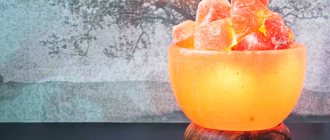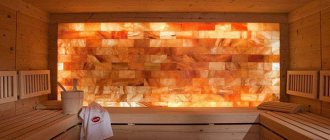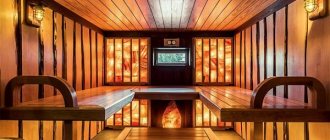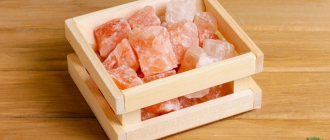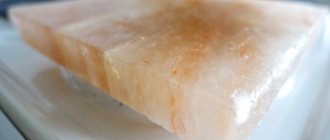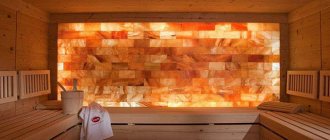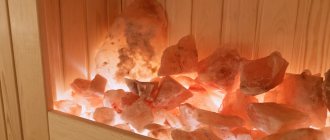Increasingly, Himalayan salt is used in modern baths, which provides a powerful healing effect on the human body.
Salt has a natural crystalline base consisting of 85 useful microelements.
Himalayan bath salt is used to treat diseases of the respiratory system, cardiovascular and central nervous systems, and to prevent colds.
In the baths, equipped with various salt elements, the air is purified and ionized.
Peculiarities
Himalayan salt is extracted in a similar way to table salt. It got its name from the location of the main mines near the Himalayas in Pakistan. The age of the mineral in these places is at least 200 million years. It was formed when ocean sediments mixed with magma. According to some data, younger caves of such salt are found in India, Poland, Ukraine, and Kyrgyzstan.
There are three types of Himalayan mineral: black, orange-red and pink.
Shades can be deeper or lighter. The color is determined by the amount of iron in the structure. The most commonly used is pink. This is exactly what we will talk about next.
Among experts, debates about the difference with table salt have not subsided for many years. Some claim that the composition is absolutely the same, others find a difference and say the opposite. The extraction method works in favor of the latter.
The process is carried out exclusively by hand, without subsequent processing or processing. This approach completely eliminates the destruction of crystals, the admixture of dirt, dust, and technical lubricants from tools. This gives grounds to call Himalayan salt the purest in the world.
The mineral reveals beneficial properties when heated. High temperatures release the elements.
In the form of water vapor, they acquire greater bioactivity and are easily absorbed by the body through the skin and respiratory tract. That’s why salt is so important in baths and various saunas.
Benefit
The microclimate from the evaporating salt is extremely similar to mountain air. It contains an impressive amount of alkali, which is beneficial to the body. 85 micronutrients are distributed along with it.
Their effects result in the following benefits:
- organs are saturated with oxygen;
- blood circulation improves;
- metabolism in tissues increases;
- bacteria and viruses die inside and outside;
- excess microelements and toxins are removed;
- muscles relax;
- water-alkaline balance is normalized;
- wound healing accelerates;
- Brain activity improves, blood pressure normalizes.
Against the backdrop of all this, long-term well-being improves and the immune system is activated.
Thus, baths with Himalayan salt are useful for general strengthening and as an auxiliary therapy in the treatment of diseases:
allergies
bronchitis, laryngitis, sinusitis and other respiratory disorders
joint diseases
muscle hypertonicity
nervous disorders, high fatigue and stress
dermatological pathologies
metabolic disorders, obesity, dysfunction
Correction of hypertension is possible. But it is important to remember that support for this disease is carried out strictly during the period when there is no exacerbation.
In addition, enriched steam disinfects the room itself, prolongs the life of solid wood, floors, and other surfaces.
Contraindications and possible harm
The main list of contraindications includes:
- renal failure;
- tuberculosis;
- oncological diseases;
- serious skin damage.
Otherwise, you should focus on individual sensitivity, avoid the period of active pathology and consult with your supervising doctor.
Harm is also possible when purchasing low-quality salt. Unscrupulous manufacturers sometimes sell ordinary salt mixed with paint and synthetic additives. Such material will not be beneficial if it evaporates and can only be used for decorative purposes, away from heat.
The note . It is extremely important to study reviews of a specific supplier or brand. If in doubt, it is better to first take the mineral for examination to a special laboratory.
Salt, fire and water
We will not take bread from medical academics and determine the importance or harm of salt entering the body with food. Let's turn to such an issue as salt in the bath. Indeed, it is not easy to overdo it with introducing salt into the body in this way, but the positive effect is obvious.
Positive effects of bath procedures with salt
There are many positives, for example:
- Salt for saunas and baths creates a wonderful atmosphere when taking procedures. There is a feeling, and not a false one, that you have been to the seaside, oh well, why be modest, to the ocean coast;
- For problems of the upper respiratory tract, aeration with salt minerals gives a guaranteed and long-term effect. It is worth remembering salt rooms for asthmatics in the system of physiotherapeutic procedures in healthcare dating back to Soviet times. Some went further, for example, on the basis of the exhausted horizons of the salt mines of the Artemsol Production Association in the city of Bakhmut, salt sanatoriums were organized with a massive intake of patients in a year-round format. It is unnecessary to say that in conditions of high temperatures and humidity the effect of salt procedures increases by an order of magnitude;
- Salt is an excellent agent that suppresses pathogenic microflora. Infectious and skin diseases have direct indications for the use of salt therapy, in which rock bath salt is an inexpensive and at the same time extremely effective tool;
- Sauna salt perfectly normalizes skin and muscle tone. Moreover, the effects of elevated air temperature and salt minerals create a complex effect, complementing each other in a balanced manner;
- Even such scourges of modern man as excess weight and hypertension are corrected with the help of salt therapy. They are being corrected. There is no need to be overly optimistic in this matter. Only the comprehensive use of systemic treatment can provide a real effect. In which various activities complement and balance each other.
As in cooking, using salt in a bath requires precise dosage.
When using salt in a bath, how to use it effectively and efficiently?
Release forms
Himalayan bath salt is produced in different forms, from crumbs to furniture and finishing blocks. In each case, you can choose a convenient method at your discretion.
Stones and crystals
Sold in bulk and individually, large and small sizes. They can be laid out on shelves, decorative elements, placed in a slide or in a bowl, and used for massage. Often used on a heater, in small steam rooms. It is preferable to pour water when heating.
Salt crumbs
It is poured into bowls, in niches on the floor, around the perimeter of the bathhouse. Good for saturating the air with alkali and disinfection, and also as a loose scrub for the skin.
Soap
Works great for treating skin. The product is moistened with water and passed over the heated skin. Quickly heals wounds, cracks, insect bites, and hives. Improves blood circulation, thereby reducing cellulite.
Lamps
Functional decor with healing properties. The lighting element is located inside the housing, cut from a single block of salt. They have different designs. They look aesthetically pleasing and produce moderate evaporation. Imitations and fakes are often found.
Furniture items
Typically, massive barrel-shaped blocks that serve as tables and stools. Suitable for humidification, excellent steam release. They have a sufficient heating area to process an average steam room.
Finishing blocks, cubes, tiles, bricks
Entire walls, floors, partitions or inserts, panels on them are mounted from them. They look extremely aesthetically pleasing and can treat a large area of public baths and saunas without much difficulty. Easy to care and use. Only the installation phase requires some skills.
Products can be polished or untreated. Texture doesn't actually affect function.
Objects can be stationary or movable. Stationary options are attached to surfaces using liquid nails, liquid glass or high-quality thermal and water-resistant glue.
Experts note that glue can release toxic substances into the air. If you are planning a large area of Himalayan salt, it is better to install it using the glueless method.
For long-term finishing, it is important to use the most dense blocks, tiles and bricks. In this case, you need to ensure that the humidity level does not go beyond 52%. Otherwise, the crystals will begin to wash out and the material will gradually deteriorate. Small decorative elements are cheaper and easier to replace. They can be used at higher humidity.
Production methods
The easiest way to make blocks is to cut them out of a layer of table salt. Since production is carried out directly in the quarry, during transportation many products receive chips and cracks, which negatively affects the installation process.
Also, the sawing method is often used to make bricks from Himalayan salt in countries where it is found (India, Pakistan, etc.). The mined salt blocks are cut, then polished and packed into boxes.
Himalayan salt processing in Pakistan
In factory conditions, pressing technology is more often used to produce salt blocks. The starting material is table salt.
The technology includes the following stages:
- grinding salt, assessing the exact parameters of humidity and grinding quality;
- place in a mixer for half an hour, bringing to the desired humidity (5-7%) by adding water;
- unloading salt into a special compartment for 8-10 hours for aging;
- placing raw materials into a mold, using a hydraulic press;
- laying blocks for curing for 7 days at room temperature, separated by polyethylene.
How to use it correctly
To ensure that a bath with Himalayan salt brings maximum benefits, you should consider some life hacks:
- thoroughly wash off cosmetics, creams, perfume, dirt from the body before entering the steam room;
- exclude the procedure in a state of alcohol or drug intoxication, exacerbation of diseases and their active stage;
- know the recommendations of the attending physician;
- at the beginning of steaming, treat the skin with a massage brush, mitten or scrub to better open the pores.”
- when using brooms, moisten them with a salt solution;
- in between steam baths, drink herbal teas and unsweetened water without gas to help the body cleanse itself and restore water-alkaline balance;
- Do not apply creams and oils to steamed skin immediately, let the body cool down a little. Avoid synthetic cosmetics until the pores are completely closed;
- At the end of the procedure, you can pour a solution of Himalayan salt on your body and let it dry naturally.
At the end of the procedure, you need to wipe the salt surfaces with a damp cloth and then wipe dry. This care will allow the blocks to last longer.
You should also pay attention to the operating conditions:
- the room must have a ventilation system to remove spent steam and moisture;
- the surface of blocks, bricks, finishing elements must be periodically treated with antiseptics, this will prevent the growth of mold in the resulting microcracks;
- if fastening with glue, take a composition with antiseptics in the composition;
- the substrate under the blocks must be thoroughly cleaned before installation;
- drafts are excluded during the installation process;
- The room must be ventilated before installation and after each use. Carry out complete drying regularly.
In such conditions, mineral elements will last a maximum period without losing their benefits.
Man and salt
Rock salt, for the most part, consists of chlorine and sodium ions. Chlorine - participates in the formation of hydrochloric acid, which is the determining component of the secretion of gastric juice, sodium is responsible for the transmission of nerve impulses in the muscles, determining the degree of performance and endurance and their general functionality. Extremely important, isn't it?
It seems that no doping is needed, I ate a kilo and a half of salt at breakfast and at lunchtime I went to set another world record. However, it is not. Everything is good in moderation and salt is no exception. In modern medicine, there has been a serious discussion about what should be considered white poison: salt or sugar? It turns out that an excess of salt is a very harmful phenomenon for the human body, in all its manifestations.
For clarity, let's look at the table. It shows the chemical composition of the salt, depending on the method of its extraction, in % by weight:
| Active substance | Self-planting | Evaporation | Stone |
| Moisture | 0,2-3,3 | 2,2-2,6 | 0,2-0,9 |
| Sodium chloride | 98-99,3 | 94,8-96,0 | 98.5-98.7 |
| Calcium salts | 0,02-0,40 | 0.3-0.4 | 0.3-0.5 |
| Magnesium salts | 0,02-0,40 | 0.1-0.2 | 0.1-0.3 |
| Sulfates | 0,02-0,50 | 1,3-1,8 | 0.01-0.70 |
| Insoluble impurities | 0.1-0,4 | 0.1-0.2 | 0.1-0.2 |
Watch the video for more details:
FAQ
Is it possible to cover an electric stove with pink salt tiles?
It is strictly not recommended to do this. Wood-burning and electric stoves are susceptible to salt vapor settling on the elements, resulting in plaque formation. As a result, short circuits, corrosion, and damage to the housing may occur. There are no such problems with stone stoves.
What is the weight of salt blocks?
Weight depends on size. Approximately 2 kg per brick 20 by 20 cm, about 2.5 cm thick.
I want to install lighting behind the salt tiles. Is it possible?
Yes, this method of use is acceptable. The diffused light of the diode strip looks especially beautiful through the prism of salt. Meanwhile, the wire elements must remain accessible; they cannot be completely walled up.
What is the best way to decorate a salt brick wall?
Alternating blocks of different shades looks advantageous. Volume and glow are created.
Is there a special glue for salt materials?
You can find such compositions in professional stores. They are harmless, durable, but very expensive (about 1000 rubles for 2 kg of dry mixture). It provides excellent adhesion to wood, concrete, plaster, brick and even plywood. The composition is prepared in portions, since it dries in no more than 20 minutes.
What other methods of installing salt bricks exist?
In addition to gluing, installation on guides is acceptable. The blocks are attached to stainless steel profiles or other metal frames. But for maximum strength, glue is also needed here.
Is it possible to line a bathhouse with salt tiles in winter?
This process is very risky. It is better to choose dry, warm weather with above-zero temperatures so that the glue sets well and the room can be ventilated from excess fumes.
Himalayan salt is a storehouse of benefits when used in a bath. With its help you can maintain beauty and health. The properties of the mineral are widely used in alternative medicine, especially by Ayurvedic doctors. In addition, salt products can decorate the interior of a steam room, which will make your vacation even more enjoyable.
Scope of application
Salt blocks look stylish, unusual and very aesthetically pleasing, and can also be used for therapeutic purposes. Initially, they were purchased only for medical institutions and for equipping so-called salt caves. Now designers are actively using attractive materials to decorate residential and office interiors.
The main directions of their installation:
- decoration of interior walls in the living room, corridor, bedroom, office;
- construction of partitions, false walls, light niches;
- creation of accent walls and individual interior elements;
- design of fireplaces, stoves, water heating elements;
- paving floors.
Salt bricks in the interior
In common areas, salt blocks will help clean and improve the air and give the effect of therapeutic ionization. The material is also ideal for cladding the premises of baths, saunas, spa complexes, halochambers, sanatoriums, both for walls and for finishing floors. Walking on salt will have a beneficial effect on the condition of your feet and overall health.
Advice! It is best to place salt near heating devices - this way the healing effect will be maximum.
